Video games have always treated guns with a certain reverence, from the wicked grin of Doom’s marine when he picks up the shotgun, to the pornographic customisation options of modern Call of Duty. Warhammer: 40k Boltgun takes this to its absurd logical endpoint. In the opening level, your hulking space marine discovers the titular firearm on a literal altar, a chorus of angelic voices chanting as you pluck the weapon from its pedestal. “A Holy Relic!” burbles your accompanying servo-skull as you lock and load. “The Emperor Provides!”
It’s a fitting introduction to Boltgun’s eponymous weapon, not just because the game revels in the excess of both 40k and mid-nineties shooters, but also in how it reflects upon its strengths and, by association, weaknesses. No other weapon is afforded such treatment, which is appropriate because no other weapon is as good. Boltgun’s boltgun is the virtual firearm perfected, so innately satisfying that it blows away the game’s own power curve alongside the hordes of daemons you’ll slaughter with it.
Unlike how it introduces its signature firearm, Boltgun doesn’t stand on ceremony getting you into the action. A brief cutscene summarises the situation. The Adeptus Mechanicus has picked up strange readings in the forge world system of Graia, and dispatches you, along with a small team of other Space Marines to investigate. But your team is killed in the initial drop, leaving you alone to battle a rapidly developing incursion by the forces of Chaos.
Visually, Boltgun derives from the Doom and Duke Nukem school of polygonal environments and sprite-based enemies. The game it most strongly reminds me of, however, is Star Wars: Dark Forces. This might be partly down to both being licensed shooters, but it’s also evident in how they use comparatively basic visual techniques to present a galaxy of vast scale. Of course, Boltgun’s technical limitations are only affected, meaning it can infuse the 40k universe with the grandeur it warrants. Across your adventure, you’ll explore sprawling gothic cityscapes and gigantic industrial complexes, where the roiling fountains of molten metal are as much a threat as the enemies clawing at your armour. They may not be as detailed as Darktide’s Tertium, but Boltgun’s maps are every bit as colossal.
Although Boltgun may look “old”, it feels distinctly modern beneath the fingers. Your space marine can zip around maps like any classic FPS avatar. But Auroch has wisely imbued a tangible sense of weight to that movement, reflecting your character’s weaponised bulk. Every footstep falls with an audible clank, while dropping from a height sounds like someone pushed a tank off a cliff (and has the same effect upon any unfortunate enemy stood beneath you when you land). It really sells you on embodying this juggernaut of a character, lending them the physical depth that their sprite-based limbs lack.
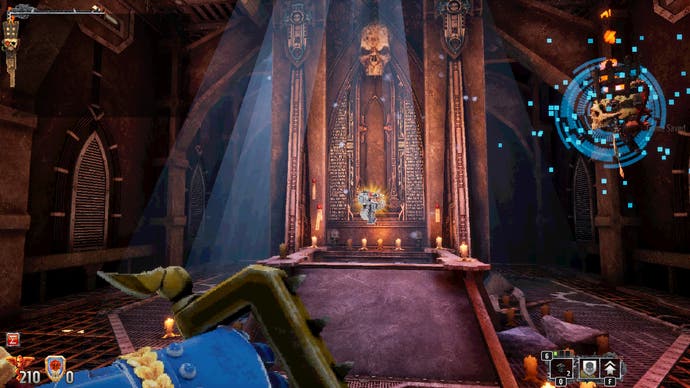
That physical depth is also extended to your enemies, though in a very different fashion. The sprites of the cultists, Chaos Marines, and daemons that you fight across the game appear neatly drawn and simply animated, until that is, you attack one with the game’s opening weapon, the chainsword. Bound to the right-mouse button, your melee attack smacks into enemies like a wet sandbag hitting concrete, then proceeds to reveal quite literal layers to your foes as it revs through pixelly flesh and bone. I thought it would be a while before a gore system delighted shocked me as much as the paint-your-own map textures system seen in Prodeus (although I am possibly failing to afford Dead Island 2 its due credit here). But Boltgun’s commitment to violence is eye-popping in every sense.
The combination of tactile satisfaction and sanguine spectacle truly gets going once you pick up the bolter. The crowning jewel in Boltgun’s arsenal spews out red hot rivets that leave a smoking trail of pixels in their wake. Any one of these glowing projectiles will crack open a cultist like the world’s worst Christmas present, coating the ground in ribbons of red. Enemies struck by several bolts will proceed to explode across the surrounding area, scattered giblets running down the walls.

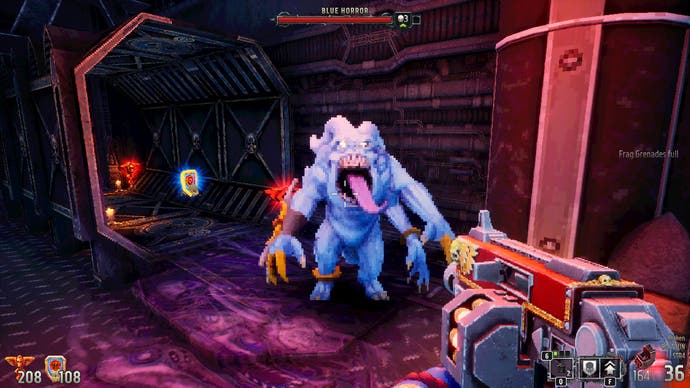
Crass as this may sound, the point is Boltgun nails the fundamentals. At its most basic level, this game is inherently fun. Auroch also ensures that your Boltgun remains relevant across the ten-hour campaign in a couple of ways. First, enemy encounters are always sprinkled with the basic cultist enemies, making quick switches to your boltgun a sensible tactical move. You’ll also pick up special magazines that fill your bolter with more powerful ammo variants, like incendiary Dragonfire bolts and penetrative Kraken projectiles. Going ham on the game’s larger adversaries with a special mag loadedis Boltgun at its peak, and I’d always smile when I found one hovering in some secluded corner of a map.
The problem, as you can probably guess, is that none of the ensuing weapons live up to the brilliance of Boltgun’s boltgun. Unusually, the shotgun is the weakest weapon in your arsenal, still adept at splattering enemies at close range, but lacking the grunt and recoil I expect from this FPS staple. The Meltagun’s ability to shoot through any obstacle promises plentiful carnage, but its ammo limit is so stingy that I was averse to using it in most situations. I am partial to the Vengeance Launcher, in no small part because it’s called “the Vengeance launcher”. But its projectiles also embed themselves in enemies before they explode, a one-two punch that always tickles me just so. Using it is always a bit of a gamble, however, as it’s perilously easy to explode yourself.
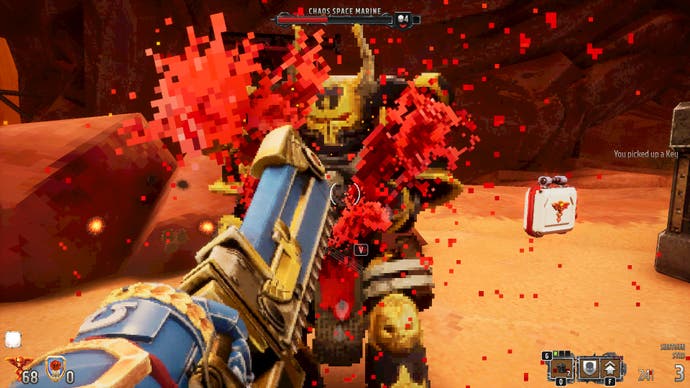

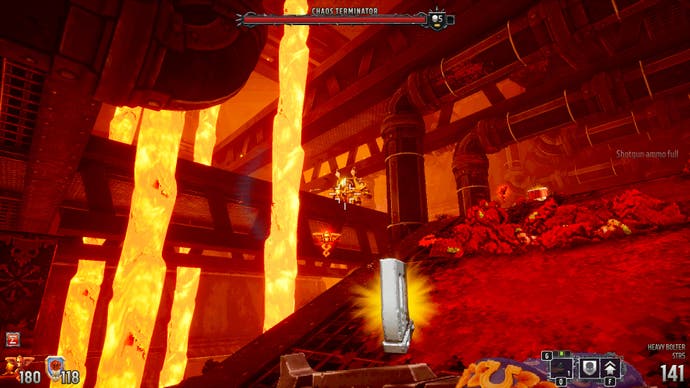
To be clear, none of the weapons are bad, and all are useful in the right circumstances. But none of them are quite as good as they could be, either. The game itself demonstrates this when, you pick up the “Machine Spirit” buff, which imbues the weapon you’re holding with special modifiers. It gives the shotgun bouncing shells like Unreal Tournament’s flak cannon, and substantially increases the plasma cannon’s rate of fire. These feel like the alt-fires the weapons should have, or at least unlock as the game progresses. Instead, they’re restricted to this rare power-up you can quite easily miss, a design decision I don’t fully understand.
This is the biggest problem Boltgun suffers from, but it isn’t the only one. Levels, as I mentioned, are impressively expansive and varied, and by and large do a good job of balancing the immensity of 40k with the “find three keys” map design of nineties shooters. But there’s also a dissatisfying looseness to the levels at times. Sometimes levels will provide a neat shortcut back to the main path once you find a key. Other times, you’ll have to backtrack through levels that you can quite easily become lost in. Sometimes this backtracking will spawn new enemies for you to fight. Other times, it won’t. Compared to the watertight mapping of Prodeus, or the pristine Slavic dungeons of the recently released HROT, there’s a bagginess here that prevents Boltgun from reaching the same heights.
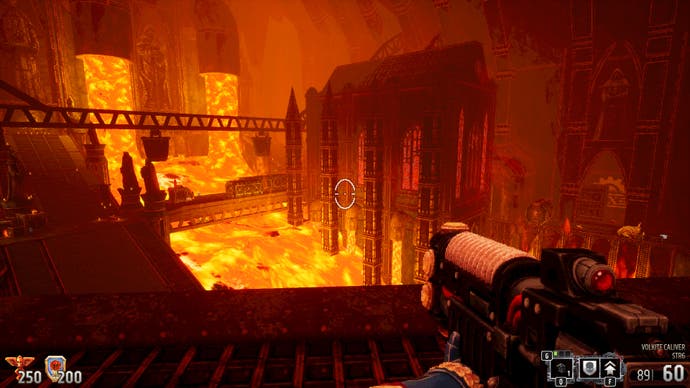

Enemies, meanwhile, threaten mainly in their numbers rather than in their skill or tenacity, though there are exceptions. Plague toads will give you some trouble in the early game, while Aspiring Champions will punish you severely if you let them get too close. Nonetheless, Boltgun’s foes are more fun to shoot than they are to fight. Boltgun also has a few boss fights that are fantastic on first encounter, but these iconic foes are reused too often, stripping them of their power and mystique.
If you want to make a big ol’ mess with one excellent gun and several other decent ones, Boltgun satisfies this desire. A few design tweaks and a little more attention to detail would elevate it from a good shooter into a great one, but as a throwback starter course to the hotly anticipated main that is Space Marine 2, Boltgun does an acceptable job of stimulating the tastebuds.
Be the first to comment